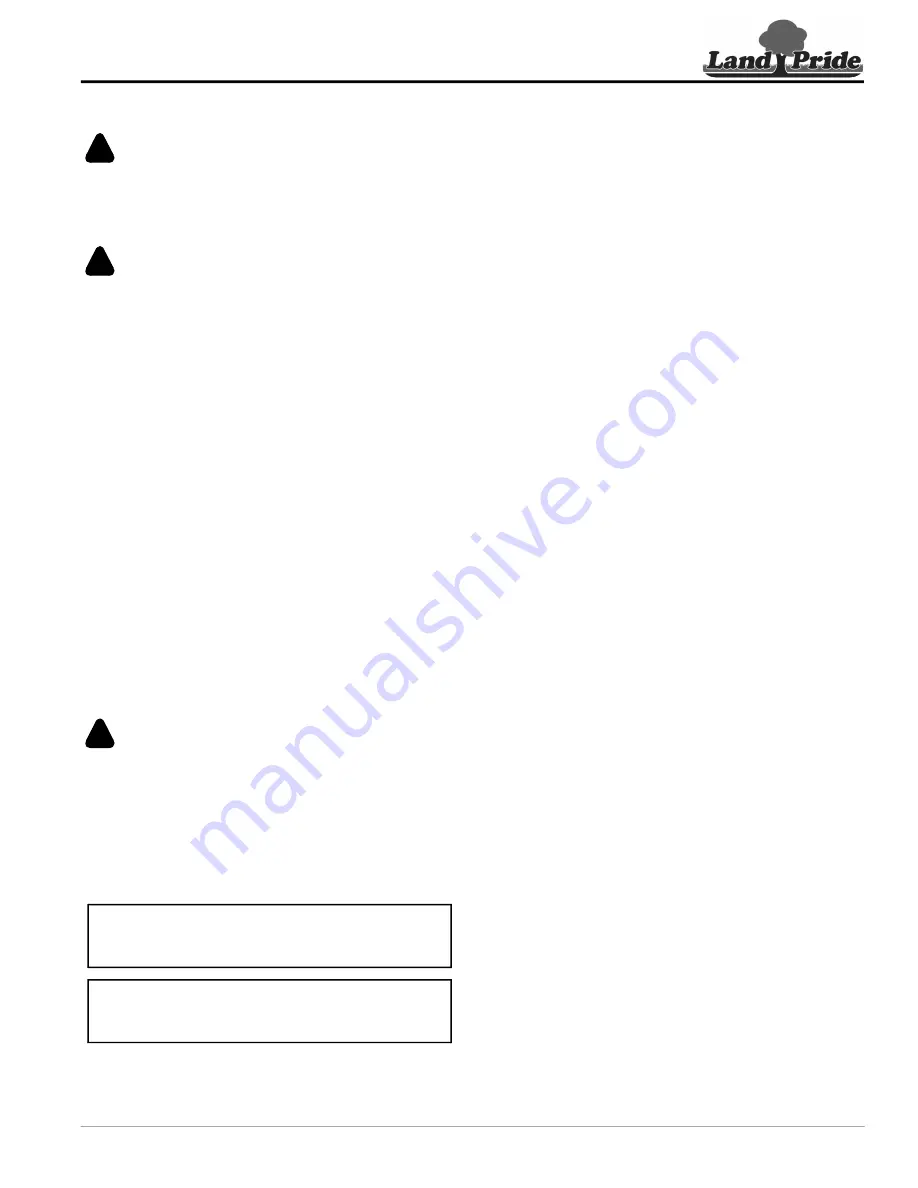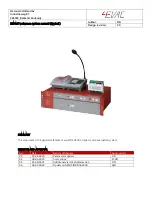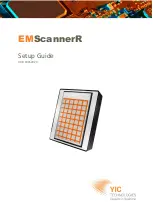
Section 2: Operating Procedures
GB2590, GB2596, GB25108, GBE2590, GBE2596, & GBE25108 Grapple Buckets 380-192M
3/3/20
19
Transport Safety
DANGER
!
To avoid serious injury or death:
Keep attachment, loader arms, and/or load away from
overhead electrical power lines. Place an orange warning
sign under overhead lines indicating type of danger above.
WARNING
!
To avoid serious injury or death:
•
Follow all safety precautions when transporting a load. Not
using safe transporting methods can damage the equipment
and cause serious injury or death.
•
Always transport loads as close to the ground as possible
without hitting objects. A load carried high could shift
causing the load to fall, tipping of the machine, and/or loss
•
Always travel straight up and straight down inclines. Never
•
Transporting loads across inclines, over ramps, on bumpy,
soft, or slippery surfaces reduces machine stability and lift
capacity. Transporting and lifting loads under these
conditions is extremely dangerous. Follow all transport
instructions in your power machine Operator’s Manual.
•
When traveling on public roadways, travel in such a way
that faster moving vehicles may pass safely. Use accessory
lights, clean reflectors, and a slow moving vehicle sign that
is visible from the back to warn operators in other vehicles
of your presence. Always comply with all federal, state, and
Grapple Bucket Operation
Picking Up A Load
WARNING
!
To avoid serious injury or death:
•
Keep bystanders at a safe distance when entering and
picking up a load. Objects can shift or be thrown suddenly
as the attachment makes contact with load causing serious
•
Enter pick-up zone carefully making sure no object will
come through or pass the attachment into the operator’s
1. Be sure to read and understand all safety alerts
under
Do not ram attachment into a pile or
hook a chain to the attachment to secure a load.
Doing so can damage the attachment.
Close upper jaw with care when lifting
fragile or hollow objects such as a crate. This will
help protect the object from being crushed.
2. Make sure the load does not exceed the rated lift
capacity of the tractor loader lifting the load.
3. Check for overhead obstructions.
4. Center bucket on the load to be picked up.
5. Make a complete stop in front of the load and position
the bucket at the proper height to enter the load.
6. Fully open grapple tines and slowly drive into the
load. Do not ram bucket into the load.
7.
Close grapple tine to secure the load.
8. Lift load a few inches and tilt it back slightly.
9. Make sure you have good control of the load. If the
load is not secure, release and recapture the load in
a more secure location.
10. Back load out slowly making sure the load clears all
other obstacles.
11. Not always will the load be secured properly in the
bucket when pulled free from a pile. Before traveling
with a loose load, lower the load to the ground,
release it, and re-capture it to make it more secure.
12. Position the load at a safe, low traveling height before
transferring it to the unloading site.
Traveling With A Load
1. Be sure to read and understand all safety alerts
under
2. Pedestrians always have the right-of-way.
3. Keep load tilted slightly back.
4. When possible, travel with bucket and load kept low
to the ground.
5. Continually scan all sides for pedestrians, other
traffic, and obstacles.
6. If the load is large and blocks your view, travel in
reverse.
7.
Always drive at a safe speed and slow down when
going around corners. Avoid sudden braking.
8. Leave enough clearance when turning so that the
bucket and load does not contact obstacles such as
vehicles, buildings, trees, or fences.
9. When traveling over a ramp or incline, keep load on
the “uphill” side of the tractor.
10. When possible, travel straight up and down grades,
ramps, and inclines. Avoid making turns on grades,
ramps, and inclines.
11. Raise or lower the load only when stopped, never
while traveling.
12. Slow down when traveling over rough or hilly terrain.
13. Do not transport loads on public roadways.
14. Transport on public roadways without a load and
transport in such a way that faster moving vehicles
may pass you safely.
15. Plan your route to avoid heavy traffic.















































